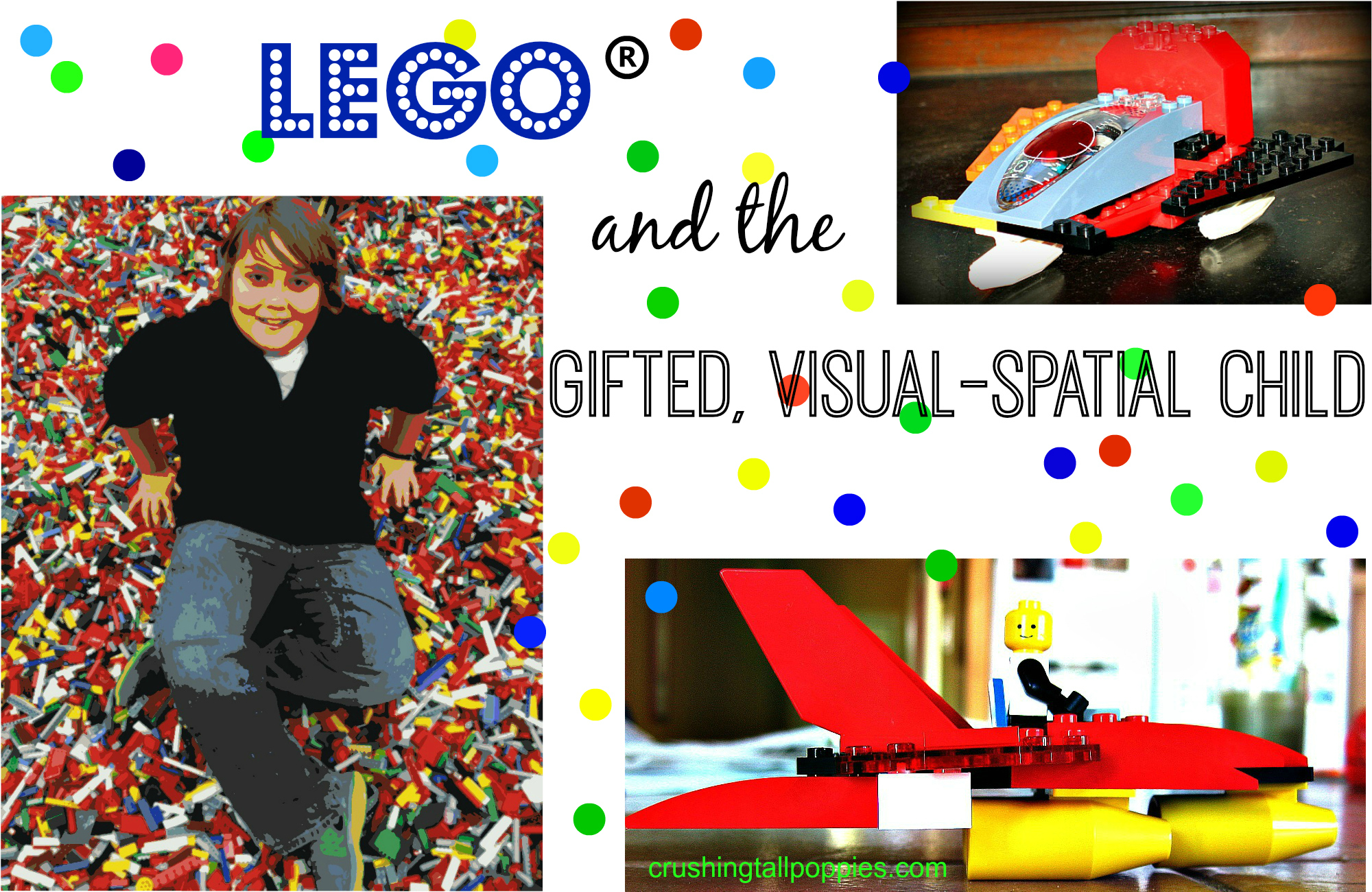LEGO® and the Gifted Visual-Spatial Child

LEGO® Is there not a more perfect toy? Boys, girls, toddlers, children and adults – everyone loves LEGO®! I would venture to claim that LEGO® are the most ubiquitous, most well-known, most-often-purchased, and THE most popular toy on the planet! Who doesn’t love LEGO® except for the parent getting up in the middle of the night in the dark and stepping on a LEGO® with bare feet? YIKES!
LEGO® are definitely an ingenious multi-use toy that has stood the test of time. The thoughts and ideas of what one can do with LEGO® keep building and growing, one idea upon the next, exponentially: construction, learning, Math, Science, art, music, transportation, engineering, robotics, Geometry, parks, stores, events…. oh this list can truly be endless. Endless possibilities, just like the toy itself!
For our gifted children, especially our visual-spatial learners, LEGO® would almost seem essential to their development. Gifted visual-spatial learners have unique characteristics and traits, and when perusing the many checklists of traits found on various sites on the internet, “loves to play with LEGO®” is always a trait on these “is your child a visual-spatial learner?” lists.
My own gifted visual-spatial son had several large containers of LEGO® bricks in each room in the house – baskets, storage ottomans, drawers, chests – you name it, it contained LEGO® bricks because they HAD to be very handy to fulfill his spontaneous, immediate and desperate need for LEGO®, right then and there! The scope of his LEGO® addiction obsession affinity? He has two, yes, two roll-out trundle beds meant to fit a single mattress, both FULL to the brim with LEGO® bricks, and that is not all of his LEGO® collection either! I want to thank hand-me-downs, garage sales, Craig’s List and eBay for helping us with his LEGO® collection!
LEGO®! Versatile – can double as a toy ensuring hours of fun as well as a teaching tool to build visual and spatial skills. Educational – can be used to introduce, build and reinforce new concepts and skills. Imaginative – the creations that can be built are only limited by a child’s imagination. The possibilities are quite endless.
The following is just a small sample of LEGO® facts, resources and links to add to your list of infinite LEGO® possibilities!
TEN FUN & INTERESTING LEGO® FACTS
- There is a bit of an ongoing debate over the grammatically correct plural form of Lego® when referring to more than one Lego® brick: LEGO®, LEGOs®, or LEGO’s®. Here is a blog post on “The Brick Blogger” about this:
- The LEGO® brick was patented in 1958.
- LEGO® founder, Ole Kirk Christiansen, came up with the name LEGO® from the Danish words LEG GODT which means “play well”.
- LEGO® was founded in Denmark in 1932. The toy is 82 years old.
- LEGO® was inducted into the National Toy Hall of Fame in 1998 and named “Toy of the Century” in 2000.
- LEGO® bricks are part of a universal system, so your bricks from today would snap on to an original brick from 1932!
- There have been enough LEGO® bricks produced for every human being on Earth to have at least 86 bricks each!
- LEGO® bricks come in 58 different colors
- The moulds used in production are accurate to within five my (=0.005mm) which means that only 18 elements in every million products fail to meet the high quality standards of LEGO®.
- The first minifig was produced in 1978, but had no printed facial features. Since then, 4 billion minifigs have been produced making it the world’s largest population group.
WEBSITES
Google Chrome and LEGO® teamed up to create “Build With Chrome”
Build Together. Awesome LEGO® Ideas for You and Your Kids
LEARNING
LEGO® Education Brick by Brick blog
Using LEGO® to Build Math Concepts
Teaching STEM with LEGO® Education
BOOKS
EVENTS
LEGO® KidsFest – Held at many locations throughout the U. S. and Canada
ROBOTICS
LEGO® on SOCIAL MEDIA – Get the latest news, updates and much more
LEGO STORES, PARKS
LEGO® Stores – List of stores around the world
ART
The Art of the Brick. A site by LEGO® artist, Nathan Sawaya
This post is part of HOAGIES’ GIFTED EDUCATION PAGE Blog Hop: Gifted @ Play. HOAGIES’ GIFTED EDUCATION PAGE is chock full of information and resources for every aspect of giftedness. Check out HOAGIES’ and go see all the other great blogs participating in HOAGIES’ June Blog Hop!
 Crushing Tall Poppies
Crushing Tall Poppies






Hello, intrigued by your post. My 8-year-old son makes incredible Lego designs, straight from his head, with moving parts and down to the finest detail! Trying to work out what this means and what direction to point him in. I do think he could be visual-spatial giftedness, but he is also gifted verbally. What is your son up to now?
He is about to graduate in mechanical engineering, which we assumed would be his path. He thought about other careers, but knew engineering was the right choice.
Hello,
My daughter, who will turn 10 in September, can easily do legos that are +18.
Is she considered gifted?
BR,
Lila
Hi Lila,
Only an evaluation by a professional to determine giftedness can answer your question. Gifted individuals have several gifted traits and behaviors that can help identify their giftedness, but an evaluation by his school or a private child psychologist is the best way to get a true identification.
Take care,
Celi
Super post! I had extreme difficulty “building” things with Legos, tinker toys, etc. This always infuriated my teachers. It never added to my learning and only added to my frustration. I wanted to know the “how” of things and never felt that these toys added to my quest. I could tell you how a switch turned on a lightbulb in a circuit but always struggled when I actually had to physically build the circuit. Even in college, I let my lab partners in physics build the lab and I just did the math. So sure, it’s probably safe to say that some gifted kids grasp concepts, which do not have to necessarily be abstract, but may not be able to physically show those concepts. That’s why computer programming languages are great for those gifted in my category…we can create something virtually without having to physically build it.
You’re right and I thank you for sharing your perspectives on visual-spatial people–they are not all created equal for sure. I love how you were able to use your specific visual-spatial talent and also work with others who were better able to complete the physical building.
Thank you!
While I appreciate LEGOs as much as the next person, I have a child who is highly visual-spatial but doesn’t get into LEGOs much. We have them, and sometimes he plays with them, but he just doesn’t get “into” it. I actually didn’t know how visual-spatial he was until he took the WISC-IV. I thought he was insanely verbal (he is almost always reading). Nope. Verbal was not nearly in the extreme range of visual-spatial.
From this, I wonder if there are kids who are a different KIND of visual-spatial. Maybe ones who have more abstract ideas about how things relate physically. Is it possible that LEGOs aren’t versatile enough for some? Or maybe not all visual-spatial people enjoy constructing. Maybe some prefer to observe (photographers?) or create (artists? sculptors?). I don’t have the answers, but I find the questions intriguing.
Shannon, I SO agree with you! Although my son loves LEGOs and definitely meets all the other visual-spatial traits, his WISC-IV scores showed his verbal scores to be higher than his scores on the tests that would demonstrate a visual-spatial thinker. There are always exceptions, and tests are not infallible. And absolutely, visual-spatials excel in the arts, too, not just LEGO and construction! It is intriguing, isn’t it? Thanks for sharing your thoughts!
Wonderful post! If we had to have just one toy at home, it would have certainly been Lego! Thanks for all the links!
Thank you and you are welcome! And ditto for LEGO® being the one toy at home!
Thanks for the information. My son loves Legos, and he still plays with his Duplos. Sometimes I think Duplos are more fun, overall because they are easier to manipulate.
Duplos are awesome, too! Aren’t Duplo and Lego interchangeable, they snap/work together I think? Love Lego®!